No. 60139 was constructed about a third of the way through the class building programme. As Darlington Works No. 2058 it was coupled to tender 759, fitted with boiler No. 3930 and completed in December 1948. It was one of five Darlington-built examples that month while Doncaster turned out three. They joined the dozen already completed. Livery was LNER apple green with black and white lining and old gold used for lettering and numerals. The tender was lettered ‘BRITISH RAILWAYS’ but the top lining was not set as high as on most A1s (see photo). It was one of eight new to King’s Cross shed (KX). While it was noted at Darlington on 31st December its first recorded train was on 19th April 1949 with the down ‘Queen of Scots’ from King’s Cross. It again headed from the capital for Leeds with a passenger train on 14th May.

In original condition, No. 60139 runs through Harringay with ‘The White Rose’ in June 1949 – F.R.Hebron/RAS
Naming and a repaint into BR blue with black and white lining came in May 1950 following a general overhaul at Doncaster. Appearing in blue was about halfway through the class and with 21 already done No. 60139 was one of five repaints that month. Sea Eagle was one of six A1 names to have previously been carried by A4s, No. 60139 being one of the earliest A1s to be named, one of three that month to follow the first pair. Sightings along the main line included King’s Cross station, leaving Newcastle with a train for the capital on 9th September and leaving King’s Cross with the down ‘Queen of Scots’ on 7th October.
Reallocation to Copley Hill (37B) along with No. 60144 came in July 1951. A repaint into BR green with orange and black lining was done in September 1951 when the locomotive returned to Doncaster for a general repair and replacement of its first boiler with No. 29850. Sea Eagle was one of these first repaints, three had been done by then and No. 60139 was one of another three repainted that month. Normal workings were now between Leeds and King’s Cross. Of note were the down ‘Tees-Tyne Pullman’ on 10th February 1953, the up ‘White Rose’ on 20th June, logged as failed at Hitchin on 26th October 1954 with the up ‘Queen of Scots’ then hauling it from Leeds to King’s Cross on 7th April 1955. Exemplifying its loads was the 11 coach 09:10hrs King’s Cross-Leeds on 7th May 1954. An undated photo shows No. 60139 carrying the ‘Yorkshire Pullman’ headboard. It was noted back in Newcastle on 29th April 1954. Sea Eagle was seen with nine Pullmans on the 16:35hrs Leeds-King’s Cross on 20th January 1955 before spending February at Doncaster undergoing a general overhaul which included equipping it with boiler No. 29839. It brought the up parcels into King’s Cross on 9th July.
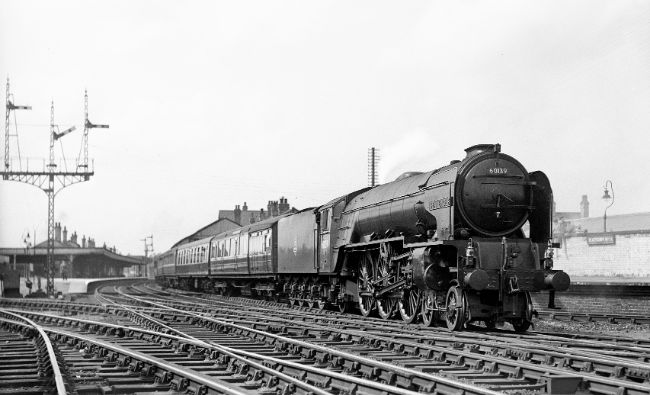
Sea Eagle at Retford on 20th June 1953 – T.G.Hepburn/RAS
In December 1955 Sea Eagle was transferred to Grantham (35B) along with No. 60119. The prestigious ‘Flying Scotsman’ was hauled in the down direction into Newcastle on 21st and 28th January 1956, then leaving King’s Cross at 10:00hrs on 19th December. Many departures from King’s Cross were observed in this period, the more common being 05:50hrs and 06:45hrs for Grantham (the latter sometimes also diagrammed with the 17:35hrs for Newcastle), the 10:20hrs for Leeds usually with a 23:45hrs departure for Newcastle and the 20:20hrs train bound for Edinburgh. Another visit to Doncaster was made in October 1956 for a ‘General’ and boiler change, this time for boiler No. 29862.
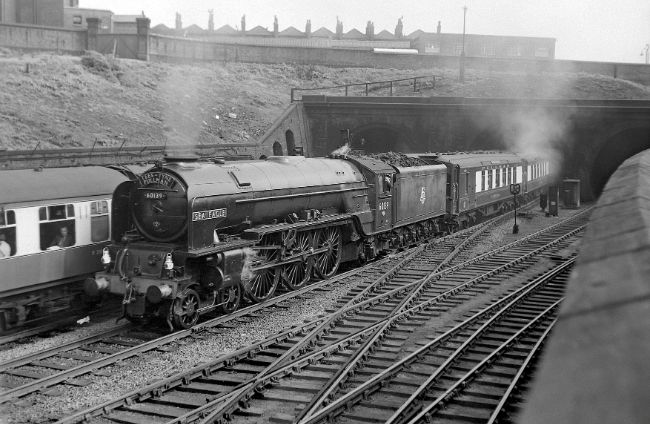
No. 60139 emerges from Gasworks Tunnel with the down ‘Tees-Tyne Pullman’, 31st May 1957 – Peter Townend
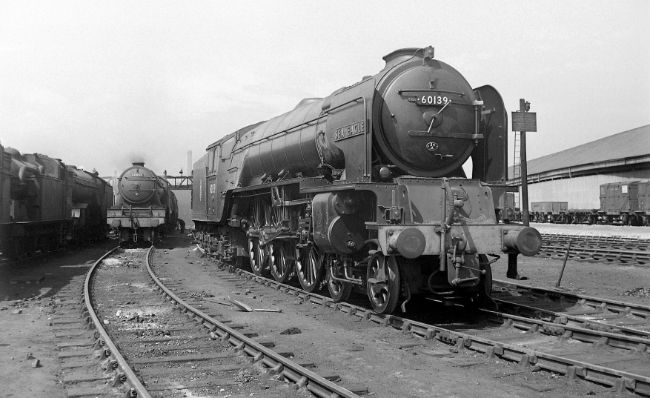
Sea Eagle on King’s Cross ‘Top Shed’ 19th August 1957 – Peter Townend
No. 60139 joined No. 60136 in going back to King’s Cross shed (now 34A) in April 1957. The later BR crest was applied to the tender in August 1958. Sightings were generally between the North East and the capital like the down ‘Flying Scotsman’ from the capital on August 27th though the same train on October 28th was hauled by No. 60138 between Newcastle and Edinburgh.
It was on the move again, this time as one of six A1s to Doncaster in April 1959 following yet another general overhaul and the fitting of boiler No. 29785, a diagram 117 example. No. 60139 was back at Doncaster again during March 1960 for another general overhaul and boiler change, receiving yet another ‘117’ in the shape of boiler No. 29786, thereafter most sightings were between Yorkshire and London but of note was taking the Hull-Kings Cross rugby special of 14th May 1960 forward from Doncaster. Sea Eagle had its final ‘General’ at Doncaster during March 1962, which included fitting its last boiler, No. 29858, a diagram 118 type, and by that summer it was back in the North East with sightings on Gateshead shed and taking Edinburgh-King’s Cross trains forward from Newcastle.
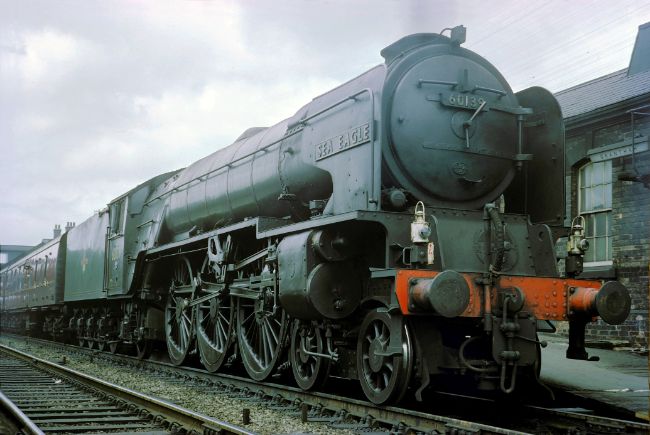
Sea Eagle at Grantham in June 1962 – Cedric Clayson
Five times between September 1962 and January 1963 it arrived in Newcastle with the 1A12 from King’s Cross destined for the Tyne Commission Quay, each time returning with the 3E22 up fish. Another goods working was the up seed potatoes leaving Newcastle at 12:37hrs on 14th December 1962. Less usual was heading south with new electric stock at York. There is an undated photo of No. 60139 on a High Dyke-Aldwarke fitted ore train. On 11th April 1963 it departed Newcastle with the 07:50hrs for King’s Cross being back two days later with the 1N25 extra Derby-Newcastle train after which it was seen light engine Blaydon to Gateshead. On 24th April it worked the 3E20 Delaval-Holloway ECS. As well as being serviced at Gateshead shed it was seen at Heaton. The last workings recorded for Sea Eagle were an up class C goods at Newcastle at 15:00hrs on 4th December 1963 and the 16:49hrs Leeds-Doncaster train of 25th April 1964. It was noted at Northallerton station 2nd May then later that day in Gateshead shed yard.
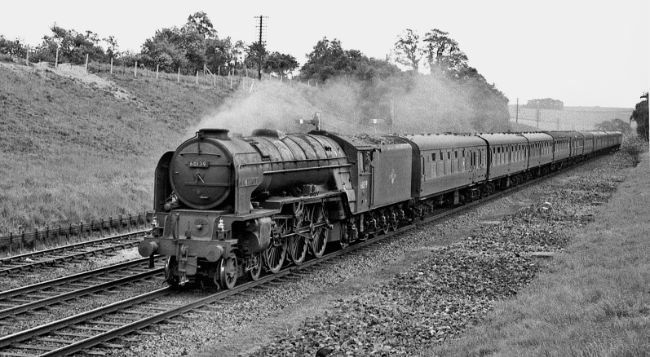
A careworn No. 60139 is seen at Great Ponton in this undated view – Bill Reed
No. 60139 carried six boilers in its life, two of them diagram 117 examples carried between August 1958 and March 1962. Its withdrawal on 7th June 1964 with No. 60149 was about a third of the way through the class with fifteen taken out of use earlier. It was in service for 15 years 8 months. It was sold for scrap to Cox & Danks of Wadsley Bridge in January 1965.
This history was compiled by Phil Champion based on the RCTS book “Locomotives of the LNER Part 2A”, a database supplied by Tommy Knox of the Gresley Society and various published photographs. Revised and updated by Graham Langer, June 2020.
Main image – Sea Eagle roars through Wood Green on 11th June 1957 with a down express from King’s Cross – Peter Townend